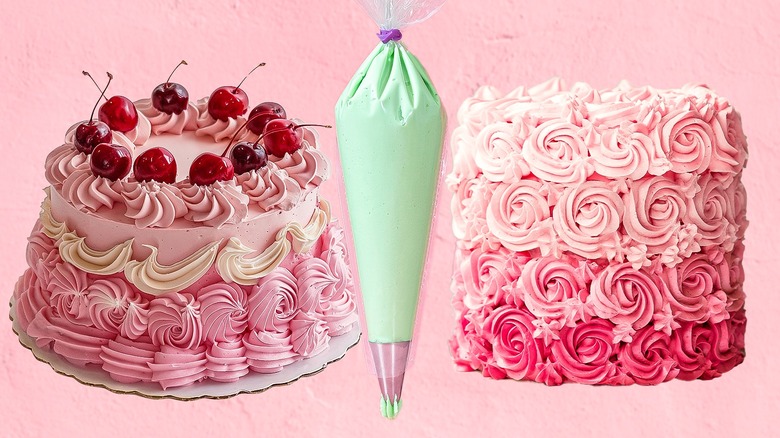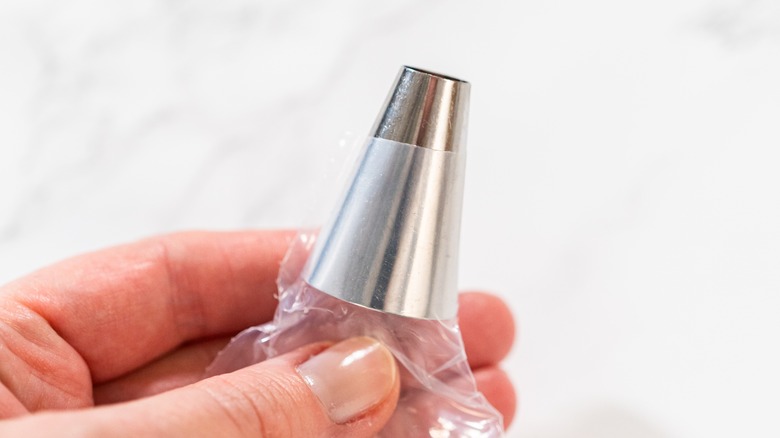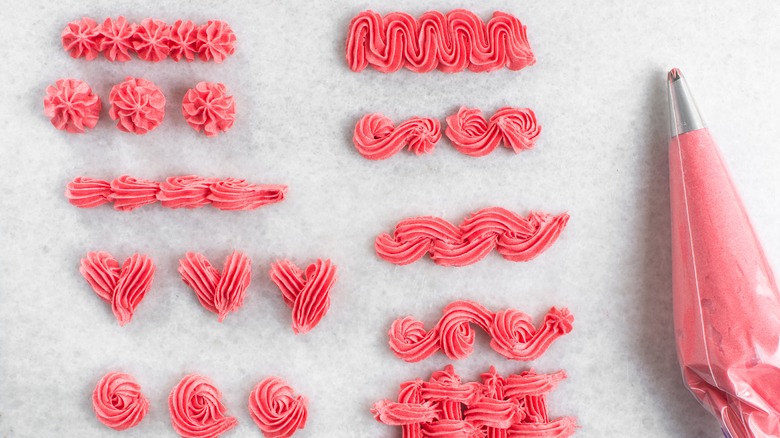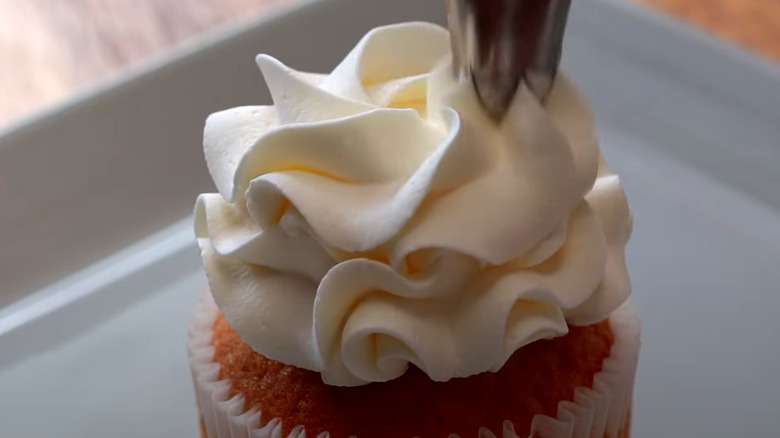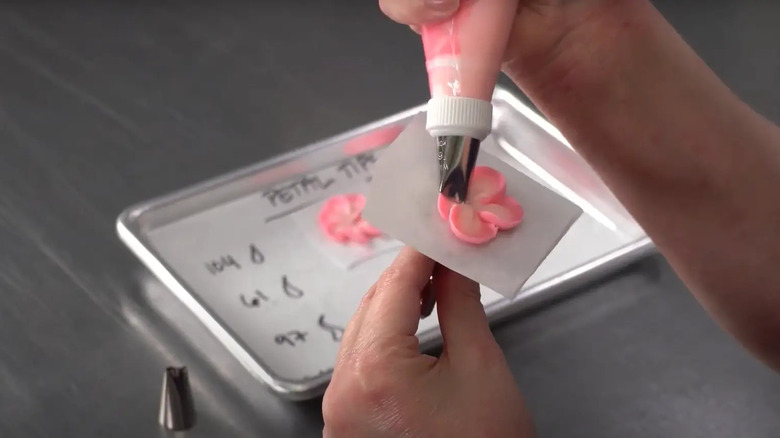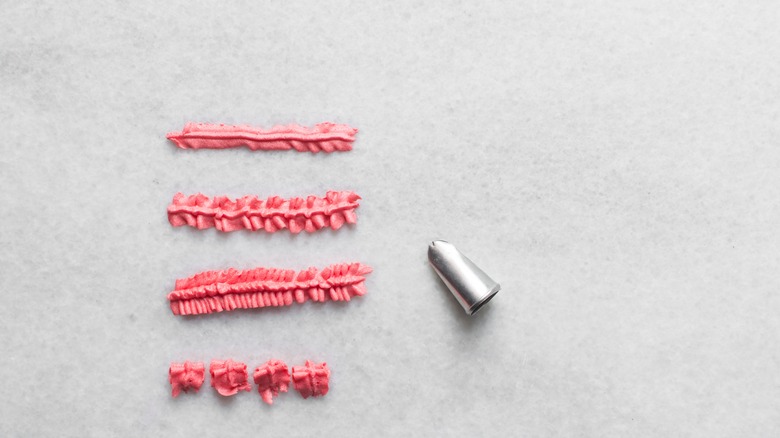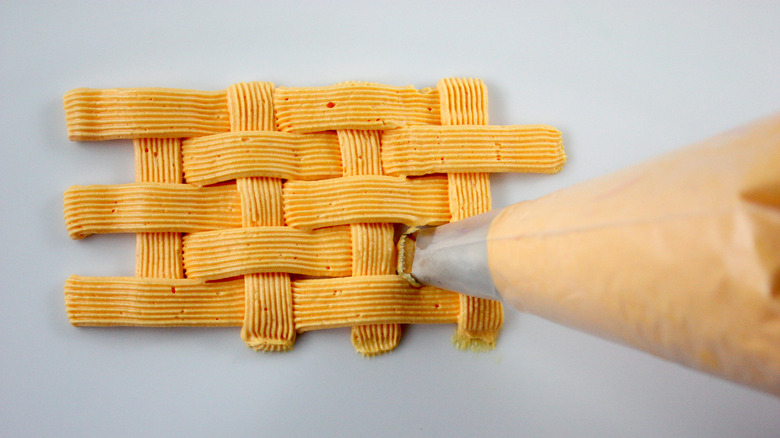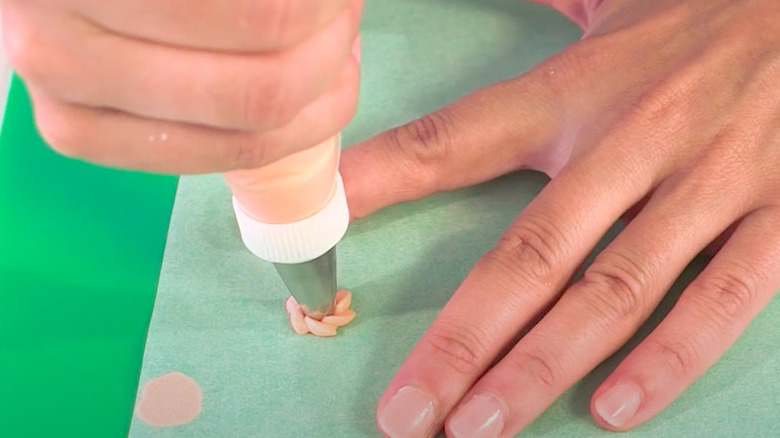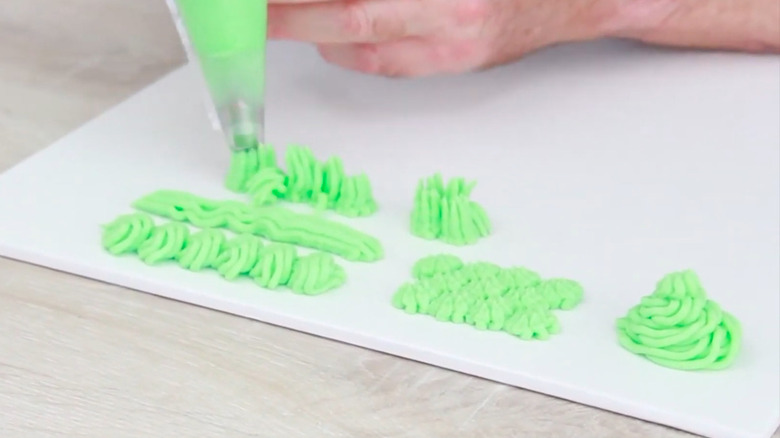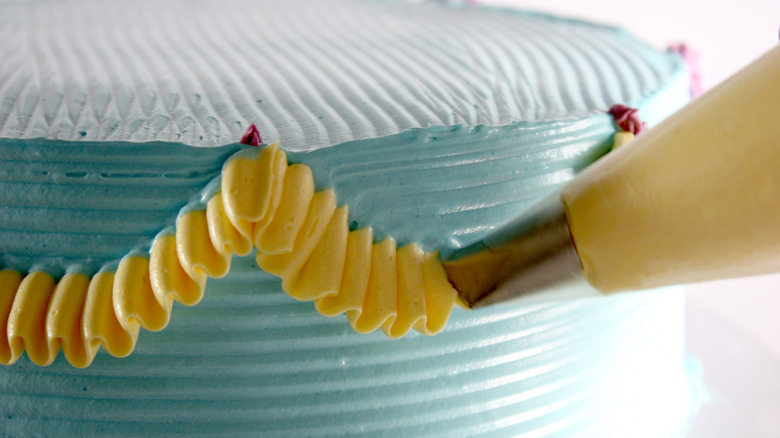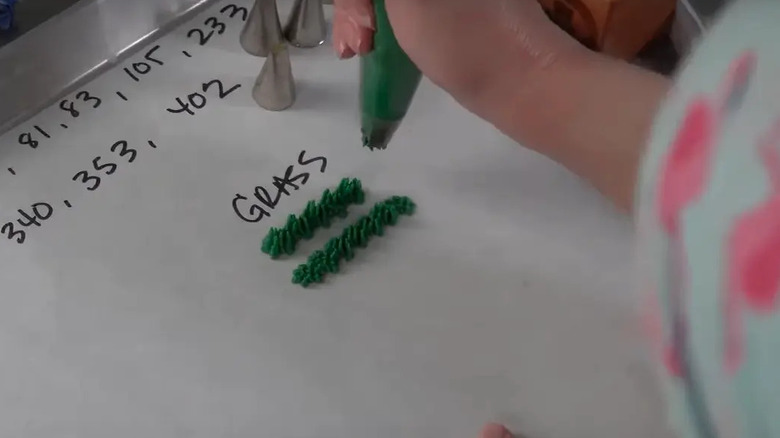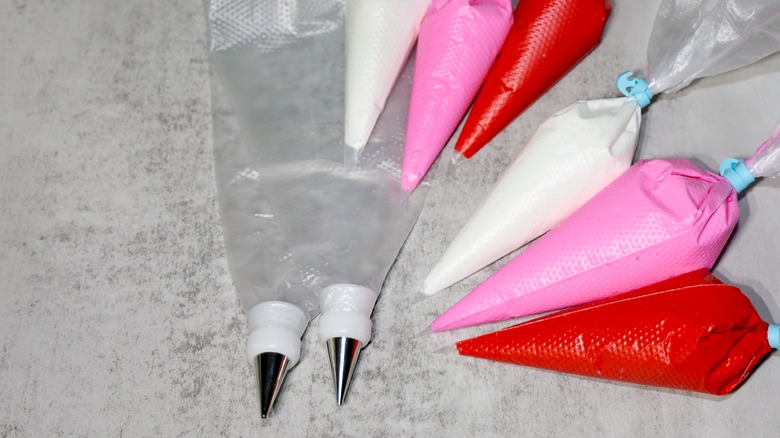A Chef Shares 11 Types Of Piping Tips That You Need To Decorate Beautiful Cakes
Cake decorating is where creativity and technique meet. The process can transform a simple cake into a true work of art. But before you run to TikTok for your cake decorating needs, take a thing or two from me. As a cook who's done some pastry prep at a few restaurants, I know that mastering beautiful designs comes down to having the right tools — and piping tips are at the core. Each type of piping tip creates unique shapes and textures, which allows you to make everything from alluring florals to intricate lace patterns.
Piping isn't just about squeezing frosting onto a cold cake; it's about creating balance, symmetry, and flair. Whether you're going for a classic look with rosettes or a modern, textured effect with ruffles and ribbons, each tip opens up new creative avenues. This guide is all about the right decorating tips for your next show-stopping cake. Grab yourself some stiff frosting, like a dense Swiss buttercream, squeeze it into a bag with no air bubbles, select your tip, and you're all set to start piping!
Round tips
Round tips are the jack of all trades of the cake decorating world. They're as essential as the cake itself, as they offer control and precision that lets you nail everything from the simplest borders to intricate lace designs. These tips are especially useful because of their versatility. Sizes like 1 through 3 are ideal for detail work — think delicate lace patterns, fine lettering, and precise dots. Larger tips, like size 10, bring you bold, clean lines, thick borders, and big, bubbly polka dots that can add playful dimension.
Round tips aren't just about making cakes look clean; they're about mastering the finer details that bring designs to life. A firm frosting, like Swiss meringue buttercream or royal icing, is ideal here, as it holds its shape and don't smudge as easily. This gives each dot, line, and accent a polished look. Round tips can also be used for borders, too; use them to create pearl-like beads that can add a touch of refinement to any cake.
Round tips make it easy to play around with details, to bring depth and character to your cake in ways that feel effortless. They're a staple in any decorator's toolkit, since they can be used to add the right finishing touch to any cake or design.
Open star tips
Open star tips are the rock stars of cake decorating. They deliver the texture, volume, and that "wow" factor that makes designs pop. Thanks to their open, jagged shape, these tips create dramatic rosettes, swirls, and shell patterns. They're fantastic for creating high-impact designs on cupcakes, too.
These tips are quite versatile; you can go from intricate to bold just by using a different sized tip. A size 18 tip, for example, is great for delicate patterns, while larger tips can help you make full swirls and eye-catching borders that add real depth to your designs. Open star tips are perfect for floral designs, too; it gives them a natural, almost three-dimensional feel. You can experiment with piping techniques like overlapping shells, layered rosettes, or multi-colored swirls to create a floral effect with real character.
Open star tips deliver that ideal mix of structure and movement and give cakes a lively texture that feels fresh and vibrant. They're perfect for creating a cake that looks like it took hours — without the actual time commitment. With open star tips, you can go from classic to modern effortlessly and transform a plain cake into something that looks as good as it tastes.
Closed star tips
Closed star tips are perfect for adding defined texture and a bit of sophistication to your frosting. Thanks to their tighter, closed ridges, these tips can create swirls, rosettes, and ruffles that have a more intricate, almost floral look. The closed tip creates a fuller, more structured edge compared to an open star tip. A size 21 closed star tip is a great place to start, but you can buy a larger variety as well. If you're layering patterns, try alternating between different sizes of closed star tips for a unique look with layers of height and detail.
Closed star tips deliver a design that's a bit more elaborate than the open tips, which makes them perfect for cakes that need a little extra flair. The deep ridges create a satisfying visual, and the structured texture feels classic and refined. With closed star tips, you can transform simple buttercream into intricate, sculpted decorations that make every cake look like a centerpiece.
Petal tips
Petal tips blur the line between cake decorating and artistry. You can use them to create lifelike flower petals, from delicate roses and lush peonies to ruffled blooms. These tips require a bit of technique, as the angle and pressure of your piping will determine the curve and thickness of each petal. The wider end of the petal tip should be pressed closer to the cake's surface, in turn allowing the narrow end to pull upward, creating a soft, natural petal effect that flows beautifully.
For intricate floral work, start with smaller petal tips and practice building your flowers layer by layer. A light touch is key to achieving those delicate edges and natural curves. After some practice, you'll find that petal tips let you add a handcrafted look to your cake that's full of dimension and charm.
These tips aren't just for flowers; use them to create ruffled edges or borders for an extra layer of detail. Petal tips bring a bit of magic to your designs by giving cakes a lush, organic look that's both striking and timeless.
Leaf tips
Leaf tips add that finishing touch to floral designs and turns them into a blooming masterpiece. These tips have a V-shaped opening, so they're relatively easy to use. Just squeeze and pull, and you've got foliage that looks surprisingly real.
Perfecting leaf piping is all about pressure control. Start by applying a bit of pressure, then gently release as you pull away to create a natural taper that mimics real leaves. With a little practice, you can layer leaves around flowers, create lush greenery, or add texture along borders for a subtle yet impactful design element. Leaf tips even work for other accents, like textured vines or grassy additions.
These tips make decorating feel effortless, but they bring that extra layer of detail that ties a whole floral theme together. Just a few well-placed leaves can elevate a cake from pretty to beautifully polished. If you want your cake to have the appearance of a lush garden, you'll want to buy an array of different-sized leaf tips.
Basketweave tips
Basketweave tips bring a cozy, rustic charm to cake decorating and allows you to create patterns that mimic woven baskets with ease. One side of the tip is smooth and the other is serrated, which will give you textured patterns that add visual depth. For an authentic basket look, start by piping horizontal lines and layering vertical ones over them. The alternating smooth and textured lines create a realistic woven effect that can add a hand-crafted touch to your cake.
Basketweave tips aren't just for full-coverage designs either; try them on borders, cake tops, or even on cupcakes. The tips allow you to create intricate textures that stand out, thus making your cake look both professional and charming.
Basketweave tips give your cake that extra bit of character; they're perfect for themes that call for texture and a bit of artistry. Whether you're going for a rustic look or looking for a way to add a unique background to floral designs, these tips bring a satisfying structure that feels fresh and inviting.
Drop flower tips
Drop flower tips are your shortcut to blooming, picture-perfect florals with zero fuss. In one press, these tips create complete, layered flowers that pop off the cake. It's a go-to for decorators wanting a lush, floral look without undergoing time-consuming petal-by-petal work. Each petal holds its edge, creating a look that's full and textured, yet tidy.
These tips are perfect for covering cakes or cupcakes in blooms, from tiny clusters of daisies to large floral accents. You can mix up the flower sizes and colors across a cake to create a design that feels fresh and organic, or layer tiny rosettes with bigger flowers to add visual depth. Drop flower tips are perfect for fast, high-impact decorating that looks like you've spent hours on it, when really, you're letting the tip do all the work.
Whether you're adding a field of flowers on top of a cake or using them as delicate accents, drop flower tips create a look that's vibrant, playful, and utterly charming. It's floral decorating made easy.
Multi-opening tips
Multi-opening tips are the hidden powerhouse of cake decorating. They're designed to make texture easy, fast, and impactful. These piping tips have multiple small openings, which lets you pipe rows of lines or dots in a single squeeze. They're perfect for creating grass-like textures, soft clusters that look like flower petals, or even shaggy fur on animal cakes. Think of them as a quick way to add volume and turn a simple surface into something dynamic with minimal effort.
For grass, go with green-colored frosting and short, controlled squeezes to mimic the look of fresh blades. For fluffy textures, experiment with different colors and larger piped sections to build up a textured, whimsical effect that adds personality.
Multi-opening tips are all about adding dimension and detail quickly. These tips bring the magic when you want a cake that looks intricate and lively without hours of work. They're your go-to for cakes with bold, fun textures that make an unforgettable statement.
Ruffle tips
Ruffle tips bring drama and elegance with just a squeeze. You can use them to create sweeping, wavy patterns that mimic soft fabric. These tips are perfect for adding cascading ruffles to tiered cake to create a look that's both structured and flowing. A medium-to-large ruffle tip can turn an ordinary cake into a statement piece, whether it's for a wedding, birthday, or any event that calls for something extra. Start with the base of each ruffle layer and build up for a look that adds height and depth. To create an ombré effect, add multiple shades of frosting to the piping bag. As you pipe, the colors will blend naturally and create layers that feel lively and modern.
Depending on your technique, you can go big and bold or keep things soft and subtle. Try piping vertically for fancy, cascading ruffles, or horizontally for a more traditional look. Ruffle tips are all about texture and movement, which will allow you to transform simple cakes into layered works of art that feel effortlessly beautiful.
Specialty tips
Specialty tips are tools for adding artistic flair to your cake. There are several different types of tips within this group. Lace tips create intricate, fabric-like patterns that add sophistication and depth. They're perfect for giving cakes a romantic, vintage feel or for adding fine detail to wedding cakes. Ribbon tips, meanwhile, produce wide, smooth bands that can be layered, ruffled, or woven together to build eye-catching textures that feel dynamic and lush.
Working with specialty tips demands a steady hand and a bit of patience, but the results are worth it. Specialty tips let you elevate your cake from a simple dessert to a unique piece of edible art. They're perfect for those special occasions when you want the cake to make a statement. With a little practice, these tips unlock endless creative possibilities and let you to personalize designs with intricate textures that bring real character to every cake.
Couplers
Couplers may not be as glamorous as piping tips, but they're an absolute game-changer for cake decorators. A coupler is a small, two-piece tool that allows you to switch between different tips without changing the piping bag. It's an essential for designs that require multiple textures and patterns. This means you can go from a round tip to a star tip to a petal tip in seconds. This, in turn, makes your decorating flow a bit more fluent and will save you headaches down the road.
If you're serious about elevating your cake designs, couplers will save you time and money. Simply unscrew the ring, swap out the tip, and keep decorating.
